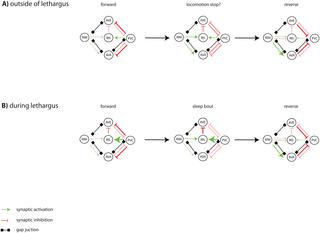当前位置:
X-MOL 学术
›
PLOS Biol.
›
论文详情
Our official English website, www.x-mol.net, welcomes your
feedback! (Note: you will need to create a separate account there.)
A wake-active locomotion circuit depolarizes a sleep-active neuron to switch on sleep.
PLOS Biology ( IF 7.8 ) Pub Date : 2020-02-20 , DOI: 10.1371/journal.pbio.3000361 Elisabeth Maluck 1, 2 , Inka Busack 1, 2 , Judith Besseling 1 , Florentin Masurat 1 , Michal Turek 1 , Karl Emanuel Busch 3 , Henrik Bringmann 1, 2
PLOS Biology ( IF 7.8 ) Pub Date : 2020-02-20 , DOI: 10.1371/journal.pbio.3000361 Elisabeth Maluck 1, 2 , Inka Busack 1, 2 , Judith Besseling 1 , Florentin Masurat 1 , Michal Turek 1 , Karl Emanuel Busch 3 , Henrik Bringmann 1, 2
Affiliation

|
Sleep-active neurons depolarize during sleep to suppress wakefulness circuits. Wake-active wake-promoting neurons in turn shut down sleep-active neurons, thus forming a bipartite flip-flop switch. However, how sleep is switched on is unclear because it is not known how wakefulness is translated into sleep-active neuron depolarization when the system is set to sleep. Using optogenetics in Caenorhabditis elegans, we solved the presynaptic circuit for depolarization of the sleep-active RIS neuron during developmentally regulated sleep, also known as lethargus. Surprisingly, we found that RIS activation requires neurons that have known roles in wakefulness and locomotion behavior. The RIM interneurons-which are active during and can induce reverse locomotion-play a complex role and can act as inhibitors of RIS when they are strongly depolarized and as activators of RIS when they are modestly depolarized. The PVC command interneurons, which are known to promote forward locomotion during wakefulness, act as major activators of RIS. The properties of these locomotion neurons are modulated during lethargus. The RIMs become less excitable. The PVCs become resistant to inhibition and have an increased capacity to activate RIS. Separate activation of neither the PVCs nor the RIMs appears to be sufficient for sleep induction; instead, our data suggest that they act in concert to activate RIS. Forward and reverse circuit activity is normally mutually exclusive. Our data suggest that RIS may be activated at the transition between forward and reverse locomotion states, perhaps when both forward (PVC) and reverse (including RIM) circuit activity overlap. While RIS is not strongly activated outside of lethargus, altered activity of the locomotion interneurons during lethargus favors strong RIS activation and thus sleep. The control of sleep-active neurons by locomotion circuits suggests that sleep control may have evolved from locomotion control. The flip-flop sleep switch in C. elegans thus requires an additional component, wake-active sleep-promoting neurons that translate wakefulness into the depolarization of a sleep-active neuron when the worm is sleepy. Wake-active sleep-promoting circuits may also be required for sleep state switching in other animals, including in mammals.
中文翻译:

唤醒活动运动电路使睡眠活动神经元去极化以开启睡眠。
睡眠活动神经元在睡眠期间会去极化,以抑制清醒回路。唤醒活动的促唤醒神经元又关闭了睡眠活动的神经元,从而形成了两部分式触发器开关。但是,尚不清楚打开睡眠的方式,因为尚不知道当系统设置为睡眠时清醒如何转换为睡眠活动性神经元去极化。使用秀丽隐杆线虫中的光遗传学,我们解决了突触前回路,用于在发育受调节的睡眠(也称为嗜睡)中使睡眠活跃的RIS神经元去极化。出人意料的是,我们发现RIS激活需要在觉醒和运动行为中具有已知作用的神经元。RIM中间神经元(在此过程中很活跃,并且可以引起反向运动)起着复杂的作用,当它们强烈去极化时,它可以作为RIS的抑制剂,而当它们被适度去极化时,则可以作为RIS的激活剂。PVC命令中间神经元已知是在清醒过程中促进向前运动的主要神经元。这些运动神经元的特性在生食期间被调节。RIM变得不那么兴奋了。PVC变得抗抑制,并具有增强的RIS激活能力。PVC和RIM的单独激活似乎不足以诱导睡眠;相反,我们的数据表明它们共同作用来激活RIS。正向和反向电路活动通常是互斥的。我们的数据表明,可能在正向和反向运动状态之间的过渡处激活RIS,也许当正向(PVC)和反向(包括RIM)电路活动重叠时。尽管RIS不在嗜睡菌中被强烈激活,但在嗜睡过程中运动中神经元活动的改变有利于强烈RIS激活,从而促进睡眠。运动回路对睡眠活动神经元的控制表明,睡眠控制可能已从运动控制演变而来。因此,秀丽隐杆线虫的触发器睡眠开关需要一个额外的组件,即唤醒活跃的睡眠促进神经元,当蠕虫处于困倦状态时,它将觉醒转变为睡眠活跃神经元的去极化。其他动物(包括哺乳动物)的睡眠状态切换也可能需要唤醒激活的睡眠促进电路。
更新日期:2020-03-02
中文翻译:

唤醒活动运动电路使睡眠活动神经元去极化以开启睡眠。
睡眠活动神经元在睡眠期间会去极化,以抑制清醒回路。唤醒活动的促唤醒神经元又关闭了睡眠活动的神经元,从而形成了两部分式触发器开关。但是,尚不清楚打开睡眠的方式,因为尚不知道当系统设置为睡眠时清醒如何转换为睡眠活动性神经元去极化。使用秀丽隐杆线虫中的光遗传学,我们解决了突触前回路,用于在发育受调节的睡眠(也称为嗜睡)中使睡眠活跃的RIS神经元去极化。出人意料的是,我们发现RIS激活需要在觉醒和运动行为中具有已知作用的神经元。RIM中间神经元(在此过程中很活跃,并且可以引起反向运动)起着复杂的作用,当它们强烈去极化时,它可以作为RIS的抑制剂,而当它们被适度去极化时,则可以作为RIS的激活剂。PVC命令中间神经元已知是在清醒过程中促进向前运动的主要神经元。这些运动神经元的特性在生食期间被调节。RIM变得不那么兴奋了。PVC变得抗抑制,并具有增强的RIS激活能力。PVC和RIM的单独激活似乎不足以诱导睡眠;相反,我们的数据表明它们共同作用来激活RIS。正向和反向电路活动通常是互斥的。我们的数据表明,可能在正向和反向运动状态之间的过渡处激活RIS,也许当正向(PVC)和反向(包括RIM)电路活动重叠时。尽管RIS不在嗜睡菌中被强烈激活,但在嗜睡过程中运动中神经元活动的改变有利于强烈RIS激活,从而促进睡眠。运动回路对睡眠活动神经元的控制表明,睡眠控制可能已从运动控制演变而来。因此,秀丽隐杆线虫的触发器睡眠开关需要一个额外的组件,即唤醒活跃的睡眠促进神经元,当蠕虫处于困倦状态时,它将觉醒转变为睡眠活跃神经元的去极化。其他动物(包括哺乳动物)的睡眠状态切换也可能需要唤醒激活的睡眠促进电路。









































 京公网安备 11010802027423号
京公网安备 11010802027423号